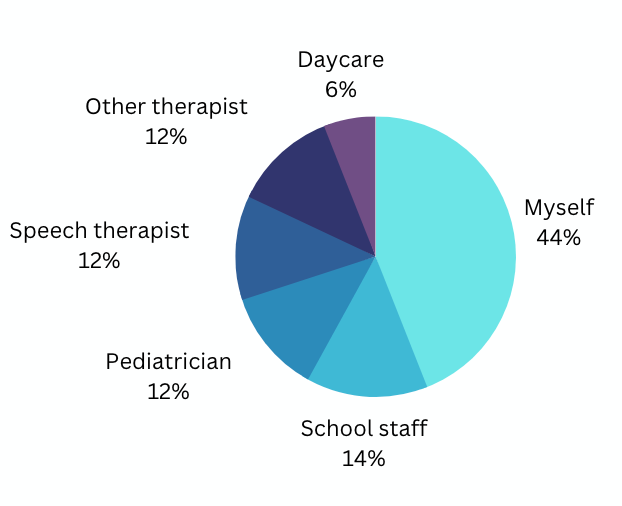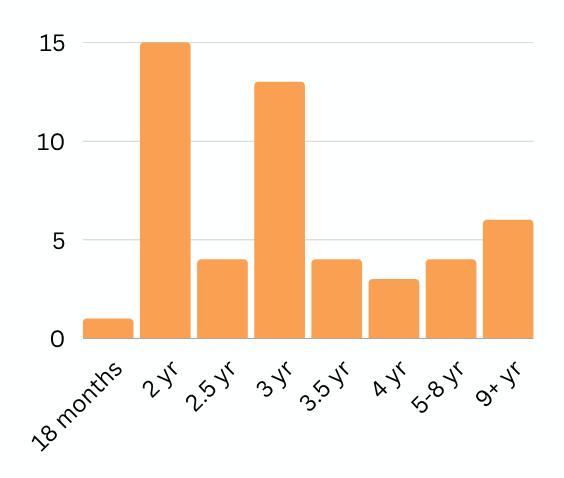When are most children diagnosed with autism? An official report
Updated: August 4, 2023 · 8 Minute Read

Reviewed by:
Amy Gong, Neurodiversity Advocate
Highlights
- Most families noticed signs of autism when their kids were 18-24 months old. The most common sign mentioned was delayed speech development.
- Most parents realized they needed to seek an autism diagnosis from their own research online. Some were prompted by school teachers or clinical professionals. 76% of parents reported waiting 12 months or more before receiving a formal diagnosis.
- 76% of parents reported waiting 12 months or more before receiving a formal diagnosis. Families were often delayed in receiving a diagnosis due to long waiting lists and a lack of awareness among providers.
- 1 in 5 families mentioned their pediatrician did not take their concerns seriously. These results highlight the importance of widespread community understanding of autism, especially among early childhood professionals.
When are most children diagnosed with autism? Given the importance of getting support early, our team took a closer look at the family journey from the moment they had concerns to a formal autism diagnosis. When do most parents first notice signs? Who prompt most parents to get an evaluation? How long did it take to get a diagnosis?
For more information about what goes into an autism diagnostic evaluation, check out our complete guide.
Survey methods
We conducted an online survey of 50 parents of autistic children ages 2–18 in the United States in May 2022. Families were asked the following questions:
- When did you first have concerns about your child’s development? Why?
- What professionals or community members prompted you to get an evaluation?
- When did your child ultimately get a formal autism diagnosis?
Summary of findings
Most families noticed signs of autism when their kids were 18–24 months old. The most common sign mentioned was delayed speech development. While every family did their own research online, most families were referred to get an autism diagnosis by a school or healthcare professional.
Families were often delayed in receiving a diagnosis due to stigma and lack of awareness among providers. 1 in 5 families mentioned their pediatrician did not take their concerns seriously. Families were also delayed due to long waiting lists, which is a consequence of insufficient access to diagnostic assessment services.
The results below underscore the importance of widespread community understanding of autism, amongst early childhood professionals as well as the public. They also highlight the need for increased access to autism diagnostic assessment services in terms of both trained professionals and insurance coverage.
How old was your child when you first had concerns about their development?

Figure 1. Child’s age when parents first had concerns about their development
On average families first had concerns when their kids were 18–24 months old, and 40% of families shared that delayed speech development caused their concerns. Many families also mentioned other atypical behaviors such as lack of eye contact, hand flapping, and feeding issues.
This highlights the importance of families understanding and monitoring the developmental milestones of their kids as they grow up.
22% of families mentioned their pediatrician did not take their concerns seriously. These responses indicate a lack of education among healthcare providers is preventing families from accessing services during these critical development years.
Who prompted you to get a diagnosis?

Figure 2. Who prompted you to seek a formal autism diagnostic evaluation
The majority of parents were prompted to seek a diagnosis by school staff or another clinical professional, however, it’s worth noting that 44% of families knew they needed one based on their own research. Every family surveyed reported that they used Google at some point in their process.
Additionally, 32% of parents mentioned they had a suspicion something was off based on how their older children had developed.
These findings suggest that parents rely heavily on the internet for information about autism, as well as underscore the importance of awareness among all early childhood professionals. Collaboration and communication between different therapy professionals help facilitate early identification and referral for evaluation.
How old was your child when they were diagnosed?

Figure 3. Child’s age when they received a medical diagnosis of autism
In our sample, children received a formal diagnosis around age 3–3.5 years old on average, though the national averages are slightly later.
Most startling is that 76% of parents reported waiting 12 months or more before receiving the formal diagnosis. This delay prohibits access to early intervention and other important supports for autistic children. Families shared that this delay was due to shortages of qualified staff as well as inadequate insurance coverage for this important service.
Finally, 15% of parents mentioned stigma and denial as playing a role in their reluctance to have their child labeled as autistic. This highlights the importance of destigmatizing autism and other developmental differences. We need to change the narrative about what it means to be autistic amongst the broader community so families feel supported.
Conclusions
These results underscore the importance of widespread community understanding of autism, especially among early childhood professionals. Understanding the signs will help ensure families everywhere know when they should be concerned, and get their children the support they need as early as possible.
These results also highlight the need for increased access to autism diagnostic assessment services in terms of both trained professionals and insurance coverage. Given the rise sharp increase in the size of the community, the need for these services will only continue to rise.
Get our best articles delivered to your inbox each month.
We respect your privacy.
Dive Deeper
Article References
- Centers for Disease Control and Prevention. Data & statistics on autism spectrum disorder. Centers for Disease Control and Prevention. Published December 2, 2021. https://www.cdc.gov/ncbddd/autism/data.html
- Shenouda J, Barrett E, Davidow AL, et al. Prevalence and Disparities in the Detection of Autism Without Intellectual Disability. Pediatrics. 2023;151(2). doi:https://doi.org/10.1542/peds.2022-056594
- CDC. Spotlight On: Delay Between First Concern to Accessing Services. Centers for Disease Control and Prevention. Published April 26, 2018. https://www.cdc.gov/ncbddd/autism/addm-community-report/delay-to-accessing-services.html













